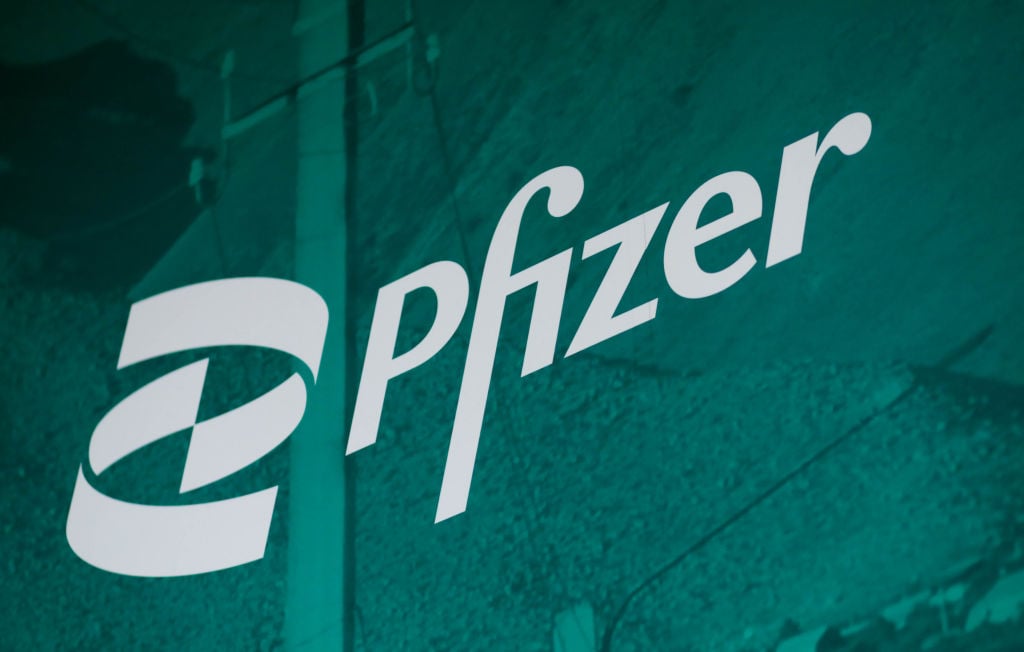
Source: Pfizer, Facebook.
Pfizer (PFE +2.09%) might be the largest pharmaceutical products company in the world by revenue, but it looks far from a force to be reckoned with at the moment.
Pfizer's problems in a nutshell
Like much of the big pharmaceutical sector, Pfizer has struggled with the loss of exclusivity on key branded drugs. The patent life on a drug in the United States begins when the Food and Drug Administration approves an investigational new drug application and lasts for 20 years. By the time a drug reaches pharmacy shelves, anywhere from five to 10 years of that exclusivity period has likely been used up during clinical testing, meaning drug developers have to squeeze every drop of margin out of their products before generic competition is introduced and prices plummet.
Over the past couple of years, Pfizer has kissed exclusivity goodbye to cholesterol-fighting drug Lipitor (which is still the best-selling drug of all time with more than $140 billion in sales since approval), overactive bladder drug Detrol, inhalable COPD treatment Spiriva in select countries, and anti-inflammatory blockbuster Celebrex just this past December. Not surprisingly, Pfizer's sales peaked at $67.8 billion in 2010 and have fallen for four consecutive years, with 2015 expected to make it five. Wall Street has forecast just $46 billion in revenue for the year.
Source: Pfizer.
Pfizer's biggest problem is that it can't organically replace its blockbuster drugs quickly enough. This isn't to say the company doesn't have a deep pipeline -- its latest drug development update in November showed Pfizer working with 86 experimental compounds, including 23 phase 3 products. Some of these figures might have changed a bit since November, but Pfizer's pipeline is reasonably deep. The problem is that it takes time for new drugs, even those with blockbuster potential such breast cancer drug Ibrance, to ramp up.
Unfortunately, a rapidly rising stock market breeds impatient investors. In other words, Pfizer must find new and innovative ways to fix its growth problems quickly if it hopes to see its stock price head any higher.
Three ways Pfizer can quickly reignite its growth engine
On the surface, the formula for Pfizer to appease shareholders is the same as with any other big pharmaceutical company: organically grow its pipeline and increase its dividends. It sounds great on paper, but Pfizer's revenue decline over the past few years speaks for itself.
Instead, I believe Pfizer can take one (or more) of the following three actions to quickly fix its growth problem.
1. Seek out a profitable acquisition or series of acquisitions
By now most investors are well aware of Pfizer's unsuccessful pursuit of AstraZeneca (AZN +1.51%) last year. The deal would have created a pharmaceutical powerhouse capable of massive cost synergies and a big tax break on corporate earnings, but AstraZeneca's price was just too high.

Source: Flickr user Thetaxhaven.
However, capitalizing on a big acquisition isn't the only way Pfizer can quickly boost growth. While a large purchase means potentially better pricing power and perhaps more market share in core focus segments, Pfizer could do just as well by focusing on small- and mid-cap companies that are growing quickly and have rapidly maturing pipelines.
As pure speculation, but to provide an example, Jazz Pharmaceuticals (JAZZ +5.24%) comes to mind. In 2012, Pfizer CEO Ian Read announced his intention to focus his company on a handful of core therapeutic areas: cardiovascular diseases, cancer, neuroscience, vaccines, and inflammation/immunology. Jazz's product pipeline is focused on neuroscience and cancer, so it would fit in nicely with Pfizer's long-term goals. Jazz, thanks largely to narcolepsy drug Xyrem, which grew sales by 36% to $222.5 million in the fourth quarter, is also slated to grow its top line by 17% in 2015 and by 16% in 2016, per Wall Street's estimates. Inclusive of Pfizer's mammoth manufacturing capacity and its experienced marketing team, adding a company like Jazz could really boost Pfizer's growth almost immediately.
2. Split into two separate companies or sell a segment
Pfizer has been tinkering with the idea of splitting itself into separate entities for more than a year now. This is the primary reason the company created three separate divisions: GEP, or global established products; GIP, or global innovative products; and vaccines. As the names suggest, its innovative products consist of newly approved and long-tail products, while its established products segment focuses on therapies that have come off patent, or are nearing the end of exclusivity.

Source: Pfizer, Facebook.
Splitting GEP from GIP has been discussed, but management has yet been unwilling to pull the trigger. Why would a split help? Most investors have a hard time distinguishing between the good and bad parts of Pfizer's portfolio, sort of how it's difficult to tell how well a bank is doing if it is carrying good loans and bad loans within the same portfolio. If Pfizer were to split these segments, investors would have better sales and profit visibility, and they could also choose whether they wanted to invest in the higher-growth, lower-dividend potential GIP portfolio, or the higher-dividend, potentially sales growth-challenged GEP portfolio.
Pfizer could also generate quick cash by putting an entire division up for sale. I'd certainly call this a long shot, but Pfizer could consider selling its GEP portfolio and instead move forward just with its innovative products, vaccines, and developing biosimilar portfolio. The only question here is who would pony up the substantial amount of money likely required to buy Pfizer's aging GEP portfolio.
3. Go collaboration "crazy"
Lastly, and excuse the nonscientific lingo, but Pfizer could consider going collaboration crazy.
If you look around, some of the largest pharmaceutical companies have demonstrated incredible success and/or willingness to partner their technologies to move experimental drugs forward. Johnson & Johnson forged a deal worth up to nearly $1 billion with Pharmacyclics back when Imbruvica was still a relatively early stage cancer drug hopeful. Now approved, Imbruvica could become a $5 billion-plus per year drug. More recently, Celgene offered what would equal more than $3 billion in up-front and milestone payments to OncoMed Pharmaceuticals for the collaborative development of up to six anti-cancer stem cell drugs.

Source: Pfizer, Facebook.
So what is Pfizer waiting for? The company is already working with Isis Pharmaceuticals (ISIS 1.47%) on a CTGF-inhibiting drug designed to treat fibrotic diseases that cause scarring. But what about the five cardiovascular drugs Isis is developing that still aren't licensed out? This isn't to say Isis is going to license out everything it is developing, but it does have collaborative deals in place for 23 of its 35 developing and approved therapies. Furthermore, we know Isis' antisense drug development platform has a good track record of success in most clinical studies.
If Pfizer wants to boost its growth prospects, it needs to seek opportunities in which it can combine its marketing and manufacturing prowess with cutting-edge medicine.
Pfizer has significant challenges ahead and is not going to be fixed overnight. But implementing one of more of these "fixes" might just speed the pace of its top-line turnaround.










